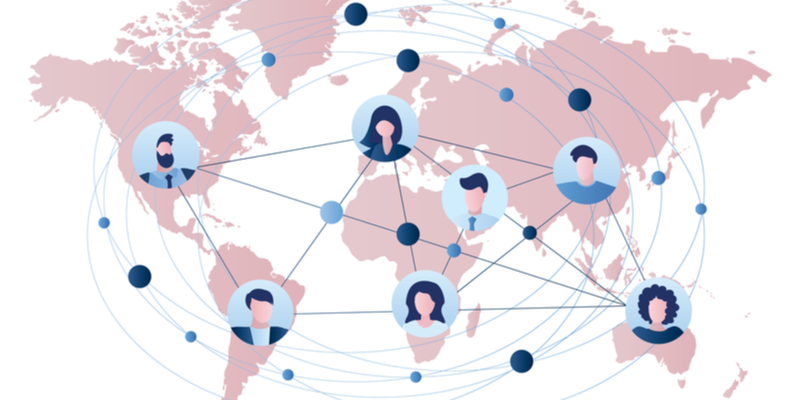
By
Leanna Seah
January 19, 2021
Updated
September 2, 2024
The new global environment
International expansion has paved the way for a borderless marketplace. Business can be conducted across various countries, time zones and cultures. Global team management becomes more complex as businesses expand.
Over the last few years, having remote employees and co-workers from different backgrounds have become increasingly common. In fact, fostering a work environment that encourages cultural diversity is celebrated by many companies.
This means that managers are now responsible for managing teams of individuals who come from different backgrounds, locations as well as levels of experience. They must be well-versed in identifying the expectations and needs of their team. And reconcile this with an eternally evolving global environment.
Common challenges of managing an international team
 source: Billion Photos/Shutterstock
source: Billion Photos/Shutterstock
Communicating effectively
Managing schedules, tracking performance, and making sure workflows are in-check isn’t an easy task. Doing so with a global workforce who don’t even share the same physical space as you? Sure a project management tool can help but it’s understandable why messages can still get lost in translation.
Not only is it a challenge within itself but it can also lead to problems like slow decision making and conflicting views. Hence why communication is often cited as a pain point for many global managers.
Implementing fair compensation packages
Differences in culture can greatly impact expectations of salary. In some locations, employees may be comfortable with having detailed conversations charting their growth and contributions to the company. Justifying their requests for increments or improved incentives. In others, a new hire might not even consider negotiating their salary despite the wealth of experience they bring.
Navigating these waters to ensure your employees are fairly compensated is a complex task. And one that requires consideration of the various cultural nuances and sensitivities that govern the situation.
Dissatisfaction with compensation is a risk for any company. To counter this, many companies offer additional benefits. Such as: Dental and medical allowances, family support packages, education allowances, fitness incentives and more.
Talent onboarding procedures
The talent onboarding process is a crucial component in familiarizing new team members with a company’s values, corporate culture and SOPs. In fact, many experts claim that it is a fantastic opportunity to engage with new employees. One that will make an impression they will carry with them for the rest of their careers.
It is an integral step in helping new hires understand the inner workings of an organization. It also determines the pace in which they can become productive team members and carry out their roles in achieving a company’s shared goals.
A geographically dispersed workforce can pose as a challenge to traditional talent onboarding modules. Some of the hurdles faced by global managers include:
- Language barriers
- Timeliness in addressing concerns and documentation
- Cultural integration
Fortunately, new technology solutions have alleviated some of the headaches associated with these tasks.
Progressive HR solutions are offering increasingly sustainable and cost-effective ways to simplify international talent onboarding. Such as online training programs and self-service modules that provide international workers with the tools they need to perform self-onboarding procedures.

Source: Alexander Supertramp/Shutterstock
Ensuring compliance with local labour laws
The rules that govern employment laws differ between countries. Therefore, ensuring compliance across a distributed workforce requires additional planning and attention to detail.
For example, the working time directive in the EU provides that workers are to work no more than 48 hours per week. In the Philippines, employees have the right to disregard all work-related communication after working hours without being penalized. In Finland, mothers are entitled up to four months of paid maternity leave whilst father can take up to 54 days of paternity leave.
Keeping track of these differences can be tricky. Pair this with the fact that regulations are always changing, it’s no wonder why maintaining compliance is one of the most important elements that come with managing remote teams.
Five ways to successfully manage international teams
 Source: Andrii Yalanskyi/Shutterstock
Source: Andrii Yalanskyi/Shutterstock
1. Respect and acknowledge cultural differences
Did you know that 67% of jobseekers consider workplace diversity as an important influencer when considering job opportunities? This might seem obvious, but you’ll be surprised by how many people often overlook cultural diversity within the workplace.
Start by communicating with your team members to educate yourself on the different cultural backgrounds that exist within your workplace. Identify how these differences can inform different approaches to work and how it can impact everyone involved.
Creating a safe space for these conversations to happen will allow you to have better awareness of different cultural requirements. And it will help you nurture the same practice of inclusion amongst your employees.
For example, if your employees have specific cultural requirements such as prayer times or dietary needs, accommodate these needs into your workplace considerations.
2. Promote inclusion through participation
It can be easy to lose sight of the individual when your team members are scattered around the world. Strengthening inclusion within these circumstances requires sustained effort. A good way to do this is to organise casual meetings where participation is encouraged. Asking for their input can really help team members feel included.
However, remember that this is an opportunity to engage with your employees, not catch them off guard. Be sure to carefully plan your meeting agenda and make it clear in advance that everyone is encouraged to participate.
As much as individual recognition is important, be sure to reinforce the fact everyone is part of a singular unit working towards a common goal. Define how each individual can fit into the achievement of that outcome and incorporate it into regular virtual team meetings or during individual check-ins.
Source: Roman Samborskyi
3, Make company resources accessible to team members
Provide international colleagues with the support they need to perform. This might include language training courses that can help bridge the fluency gap or a social intranet that international colleagues can use to access learning modules and share knowledge.
Many global organizations offer Employee Assistance Programs (EAP) that are designed to help employees resolve personal issues that may adversely affect their workplace performance. Support can occur in the form of mental heath care, legal assistance, child or elder care and financial counselling.
4. Build trust
Global teams work best when colleagues can communicate openly and understand where the other person is coming from. A savvy team leader should build a company culture where members feel comfortable being honest with their manager and one-another.
Unstructured, informal communication is a fantastic way to promote organic conversation. Use this as an opportunity to share more about yourself and get to know your entire team by asking questions about things they care about.
When people feel they can speak openly, you establish a dynamic of trust. This creates a space where people will be more at ease with providing feedback, embracing constructive criticism, and checking in on one another.
Source: Naum/Shutterstock
5. Communicate frequently
Frequent and clear communication is especially important for global teams. Even more so when you can’t simply walk across the room to speak with Mark from IT. Online team huddles and meetings that occur regularly are valuable periods of time that allow team members to exchange knowledge in real time, keep people updated on organizational developments, monitor progress, identify pain points and more.It is important to acknowledge time zone difference. You can’t expect to get a response to your emails immediately if you’re communicating with a team member 12 hours behind you. Scheduling your emails to go out around the time your team member starts work and reiterating that emails don’t need to be responded to immediately are some practices that can be observed.
In many cases, it’s best to employ multiple platforms for interacting. The correct medium for communication plays an important role in ensuring optimum employee productivity and effective collaboration. Invest in software for video conference calls and document sharing to find a common ground that allows communication to occur efficiently. When possible, make time for face-to-face communication.
One also mustn’t forget that being a manager also means being an attentive listener. Hear what your employees have to say and do so with an open mind. This can help you better understand their needs and make more effective decisions for the betterment of the individual, your team and the company.
Airswift: 40 years of global workforce management support
At Airswift, we know that going global is about more than seizing new opportunities—it also brings new risks. Navigating these challenges in unfamiliar territories requires the right expertise, and that's where we come in.
Global Employment and Mobility services are at the core of what we do. We operate in over 60 countries worldwide, offering comprehensive solutions. Our Employer of Record (EOR) services, for example, can manage various aspects of your international workforce, including HR services, legal entity establishment, and fully compliant tax and payroll processing.
Contact us today to learn how we can support your international expansion goals.
